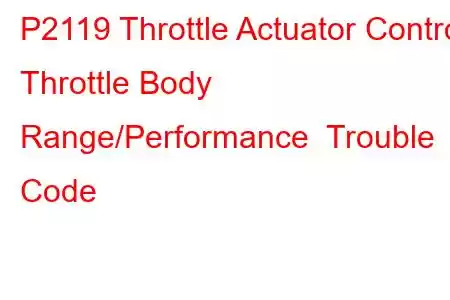P2119 Throttle Actuator Control Throttle Body Range
OBD-II Trouble Code Technical Description
Throttle Actuator Control Throttle Body Range/Performance
What does that mean?
This generic powertrain diagnostic trouble code (DTC) typically applies to all OBD-II equipped vehicles that use a drive-by-wire throttle control system including but not limited to vehicles from Ford, Mazda, Nissan, Chevy, Toyota, Cadillac, GMC, Land Rover, etc.
The P2119 OBD-II trouble code is one of number of possible codes that indicates that the Powertrain Control Module (PCM) has detected a malfunction with the operation of the Throttle Actuator Control System.
There are six codes that are associated with Throttle Actuator Control System malfunctions and they are P2107, P2108, P2111, P2112, P2118 and P2119. Code P2119 is set by the PCM when the Throttle Actuator Throtle Body is out of range or not performing properly.
The PCM controls the Throttle Actuator Control System by monitoring one or more throttle position sensors. The operation of the throttle body is determined by the position of the throttle plate that is controlled by one or more Throttle Actuator Control Motors. The PCM also monitors the accelerator pedal position sensor to determine how fast the driver wants to go and then determines the appropriate throttle response. The PCM accomplishes this by a changing current flow to the Throttle Actuator Control Motor that moves the throttle plate to the desired position. Some malfunctions will cause the PCM to restrict the operation of the Throttle Actuator Control System. This is known as fail-safe or limp mode where the engine is held at idle or may not start at all.
Code Severity & Symptoms
The severity of this code can be moderate to severe based on the specific malfunction. Symptoms of a P2119 trouble code may include:
Engine will not start Poor performance that progresses Little, or no throttle response Check Engine Light illuminated Smoke from tailpipe Increased fuel consumptionCommon Causes Of A P2119 Code
Possible causes of this code may include:
Faulty throttle body Dirty throttle plate or linkage Faulty throttle position sensor Defective accelerator pedal position sensor Throttle actuator control motor is defective Corroded or damaged connector Faulty or damaged wiring Faulty PCMCommon Repairs
Replacing throttle body Cleaning throttle plate and linkage Replacing throttle position sensor Replacing throttle actuator control motor Replacing accelerator pedal position sensor Cleaning corrosion from connectors Repairing or replacing wiring Flashing or replacing PCMDiagnostic and Repair Procedures
Check for TSBs
The first step in the troubleshooting process for any malfunction is to research the Technical Service Bulletins (TSB's) for the specific vehicle by year, model and power plant. In some circumstances this can save a lot of time in the long run by pointing you in the right direction.
The second step is to locate all of the components associated with the Throttle Actuator Control System. This will include the throttle body, throttle position sensor, throttle actuator control motor, the PCM and the accelerator position sensor on a simplex system. Once these components are located a thorough visual inspection should be performed to check all of the associated wiring for obvious defects such as scraping, rubbing, bare wires, burn spots or melted plastic. Next is to check the connectors to every component for security, corrosion and damaged pins.
The last visual and physical inspection is the throttle plate. With the ignition switch off, you should be able to rotate the throttle plate by pushing in on it. It should rotate to the wide open position. If there is sludge behind the plate it should be cleaned while it is accessible.
Advanced Steps
The advance
Read: 20


